Japan’s major cruise ports include Tokyo (Yokohama), Osaka (Kobe), Hiroshima, Nagasaki, and Okinawa.
For other Asia Cruise destinations check out our Asia Cruise ship Ports Guide page.
You’ll find modern terminals with all the good stuff like free Wi-Fi and places to swap your money. Each port has its own cool vibe—check out Yokohama’s bustling Chinatown, grab a moment of reflection at Hiroshima’s Peace Memorial Park, or explore Nagasaki’s amazing UNESCO sites.
Getting around is a breeze with shuttles, trams, and trains that’ll take you to nearby cultural hotspots. These ports aren’t just stopping points—they’re gateways to dive into what makes Japan special.
Tokyo (Yokohama) Cruise Ship Port Guide
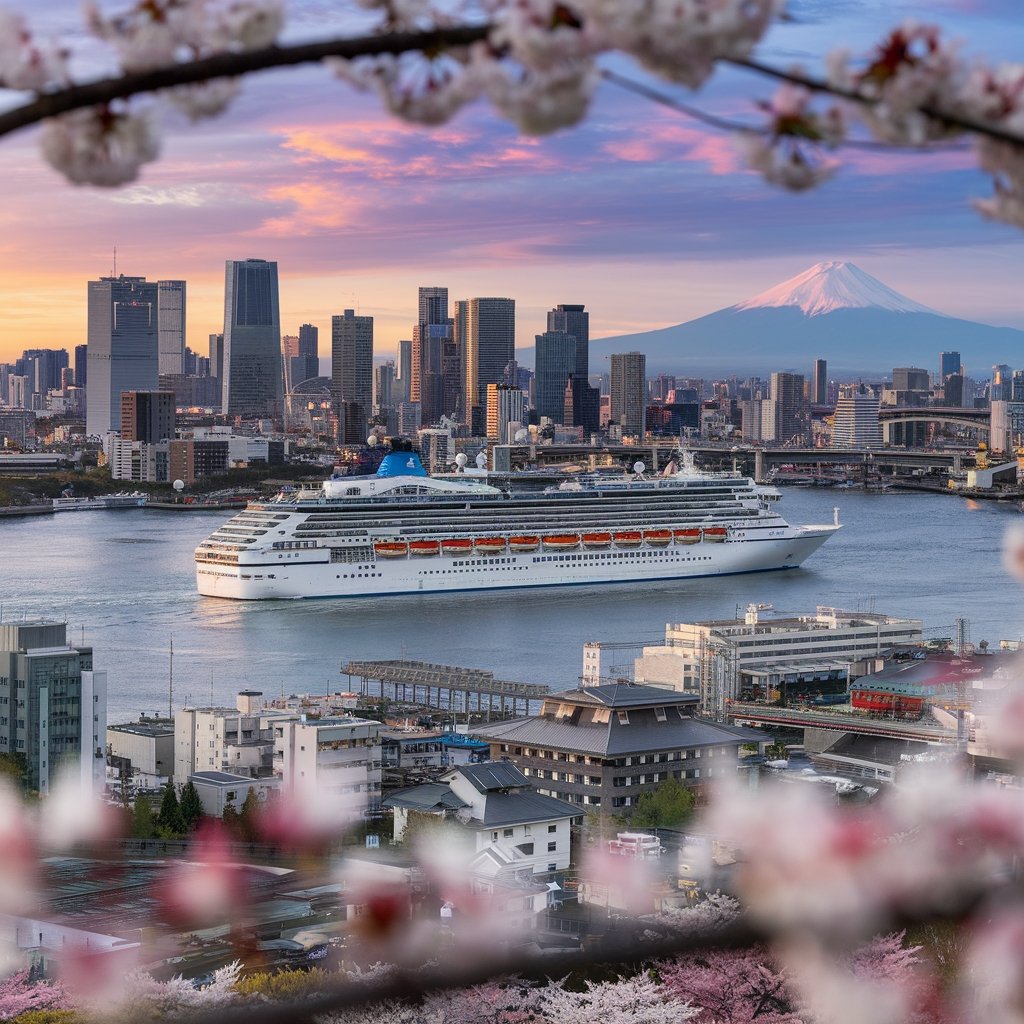
Tokyo (Yokohama) Cruise Ship Port Guide
Locals call it Yokohama, but let’s be real – this buzzing port is really Tokyo’s main cruise hub, sitting just 28 km south of the capital right on Tokyo Bay. It’s got some history too – Japan’s first proper international trading port since 1859 and likely your jumping-off point for exploring Japan.
The port splits into three terminals: Osanbashi (check out that awesome rooftop deck!), Daikoku for those massive ships that can’t fit elsewhere, and Shinko where you can shop while you wait. Don’t worry about the basics – they’ve all got free Wi-Fi and places to swap your cash.
The best part? Step off your ship and you’re already in the action. Yokohama’s famous Chinatown and the cool Minato Mirai district are just a short walk away.
Osaka (Kobe) Cruise Ship Port Guide
Osaka (Kobe) Cruise Ship Port Guide
Kobe and Osaka sit right next to each other on Osaka Bay, making up Japan’s cruise port dream team. Kobe takes the big ships while Osaka handles the smaller ones. If you’re cruising into Kobe, you’ll dock at the artificial island terminals – just hop on the Port Liner for a quick 5-minute ride downtown. In Osaka, you’ll pull up to Tempozan Pier, which is super close to the awesome Kaiyukan Aquarium.
Whichever port you land at, you’re in a sweet spot to check out:
- Kobe’s pretty Meriken Park and the shops at Motomachi Arcade
- Osaka’s food paradise in Dotonbori and the rides at Universal Studios Japan
- Easy train trips to see Kyoto’s gorgeous temples or the impressive Himeji Castle
Kyoto (Osaka) Cruise Ship Port Guide
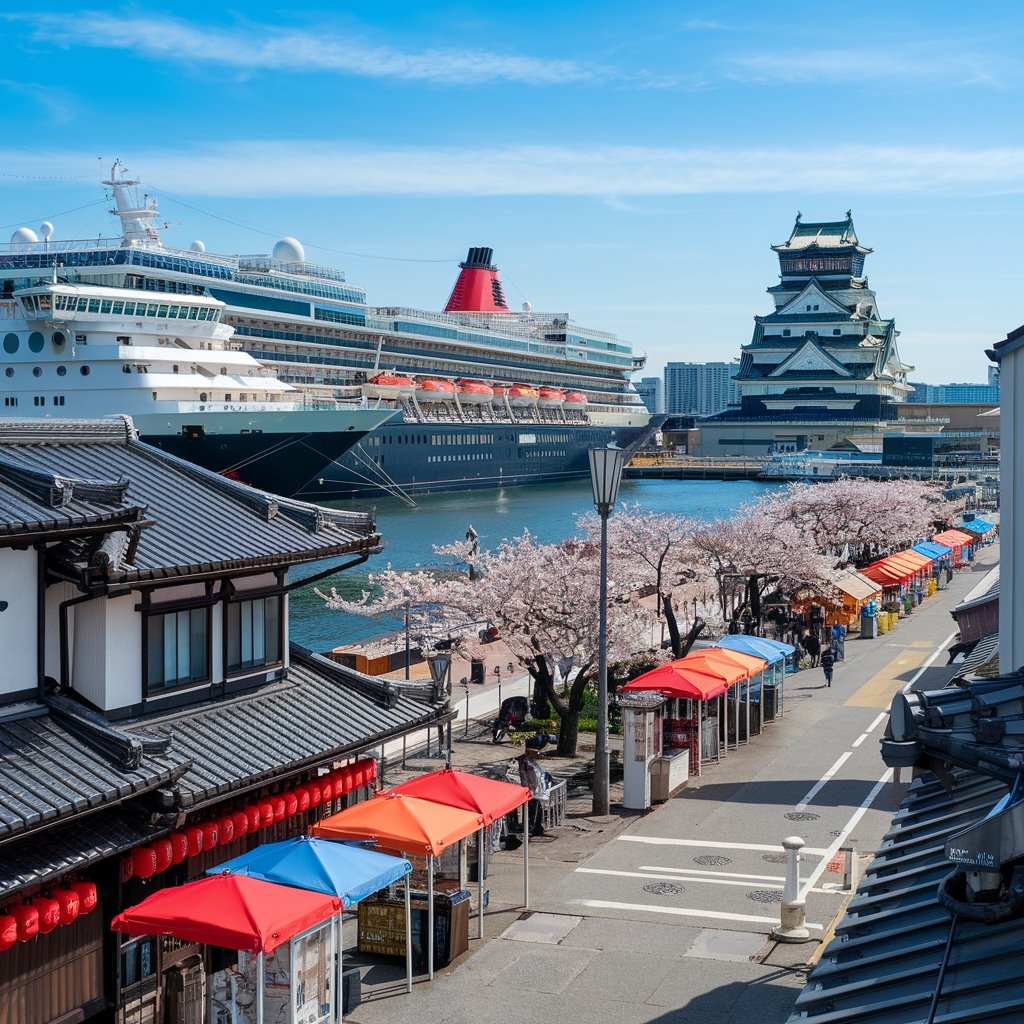
Kyoto (Osaka) Cruise Ship Port Guide
Kyoto might be landlocked, but cruise travelers can still check it out thanks to Maizuru port in Kyoto Prefecture’s protected bay. When you dock at the International Wharf, you’ll notice their hospitality is top-notch.
From here, just hop on a 90-minute train ride to explore Kyoto’s UNESCO sites. The gold-covered Kinkaku-ji temple is stunning, and those endless red gates at Fushimi Inari are perfect for photos. If you have time, head to Amanohashidate to see the famous pine tree-lined sandbar that locals rave about.
Make your trip special with some real Japanese experiences – sit in on a traditional tea ceremony, catch a maiko dance performance, or treat yourself to seasonal kaiseki food. Trust me, these little touches really make you feel connected to Japan’s culture.
Hiroshima Cruise Ship Port Guide
Hiroshima Cruise Ship Port Guide
You’ll find a powerful mix of heartbreaking history and impressive rebirth when you dock at Hiroshima. The cruise ships pull into Ujina Wharf, just 3km from downtown, with all the basics covered – Wi-Fi, places to exchange money, and cash machines.
Getting around is pretty straightforward:
- Hop on the free shuttle to Hiroshima Minato Park, then jump on a tram into the city
- Take a ferry straight to Miyajima Island to see that famous floating gate everyone photographs
- Grab a taxi if you’re in a hurry (it’ll cost you about ¥4,200 to reach the Peace Park)
Make time for the Peace Memorial Park and Museum, a trip to Miyajima Island, and Hiroshima Castle. They tell the story of a city that refused to stay broken.
Nagasaki Cruise Ship Port Guide

Nagasaki is just as powerful as Hiroshima when it comes to atomic history, but with its own special vibe and comeback story. You’ll pull into a pretty sweet modern terminal that boasts Japan’s biggest customs facilities and a killer rooftop garden with amazing views.
The best part? You can walk to some seriously cool UNESCO spots in just 15 minutes—check out Glover Garden, Oura Church, and Dejima. Make sure to swing by Shinchi Chinatown for some grub, and definitely hit the Peace Park while you’re there.
The terminal’s got you covered with free Wi-Fi and staff who speak multiple languages. Trams are the way to go—grab a day pass for 500 yen and you’re set. Oh, and pack decent shoes! Those Nagasaki hills are no joke—they’ll give your calves a workout for sure.
Fukuoka (Hakata) Cruise Ship Port Guide
Fukuoka welcomes cruise passengers at two main spots: the bustling Chuo Wharf and the more laid-back Hakozaki Wharf, both roughly 4-5 km from downtown. Chuo’s got better amenities and runs free shuttle buses to Hakata Station, while taxis will set you back ¥1,500-¥2,500 if you’re in a hurry to hit the city.
While you’re in town, make sure to:
- Slurp up some killer tonkotsu ramen at the lively yatai food stalls on Nakasu Island
- Check out the ancient Kushida-jinja Shrine from the 700s – it’s where locals have been praying for centuries
- Hop on a traditional boat and cruise Yanagawa’s pretty canals (the boatmen do all the work!)
Kagoshima Cruise Ship Port Guide
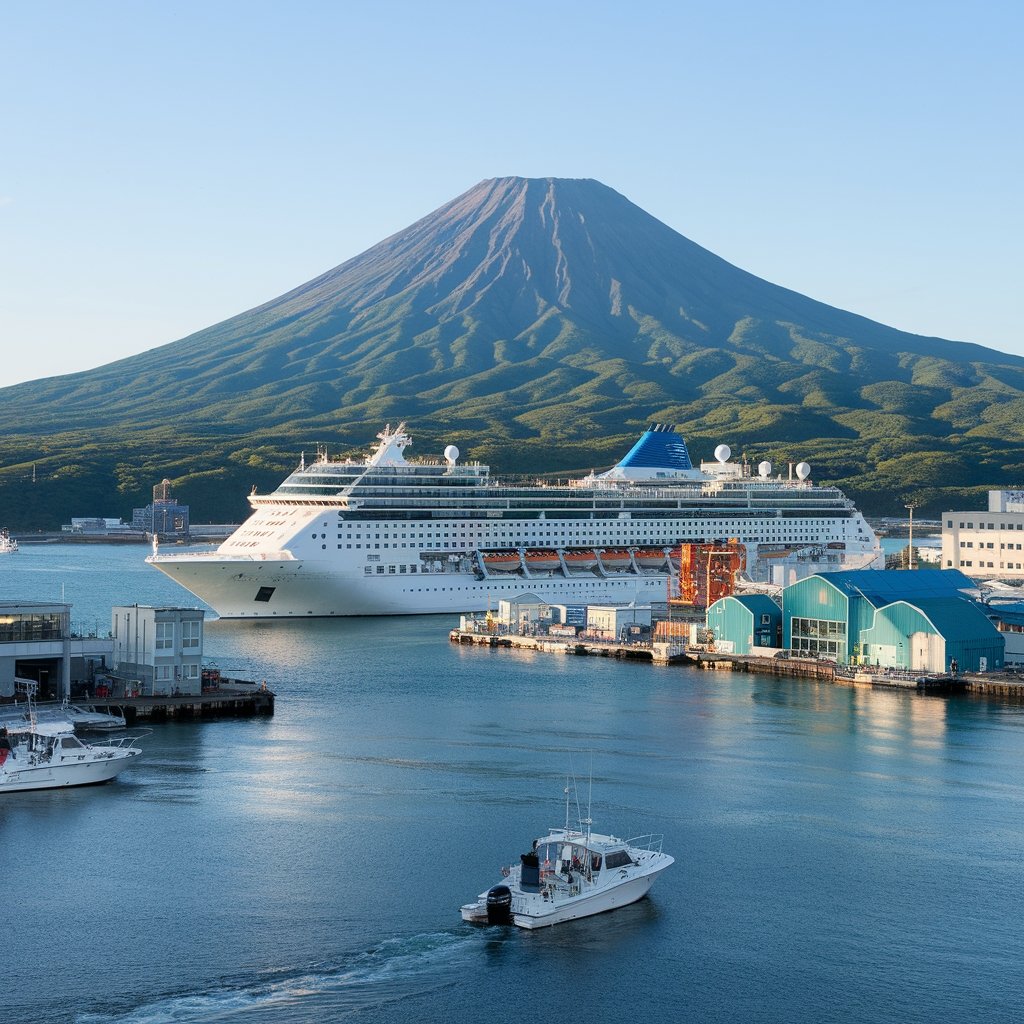
Kagoshima’s cruise terminal sits right in the shadow of Sakurajima volcano, giving you killer views across Kinko Bay as soon as you dock. The 340m berth can handle the big ships no problem, and inside you’ll find customs, a decent-sized lobby (880㎡), and free Wi-Fi to update your socials.
Getting around is pretty easy – grab a taxi right outside, walk about 20 minutes to Wakida Station for the tram, or hop on one of the shuttle buses heading to the Tenmonkan shopping district. If you’ve got time, check out Senganen Garden (it’s UNESCO listed) or jump on the quick ferry to Sakurajima where you can hike around an actual active volcano.
The locals are super friendly – they often show up when ships arrive with traditional dances and music. Makes for a nice welcome to this cool southern city!
Shimizu (Mount Fuji) Cruise Ship Port Guide
Shimizu (Mount Fuji) Cruise Ship Port Guide
Shimizu Port in Shizuoka Prefecture will knock your socks off with jaw-dropping views of Mount Fuji and Suruga Bay right when you step off the ship. You’ll pull into Hinode Pier, where the terminal hooks you up with free Wi-Fi and tourist maps to get your bearings.
While poking around town, you’ll stumble upon:
- The UNESCO-listed Miho-no-Matsubara pine grove that runs for a solid 5km along the shoreline
- Kashi-no-Ichi Fish Market, perfect for grabbing some crazy-fresh tuna and those tiny local sakura shrimp
- Nihondaira Plateau’s Yume Terrace, where you can snap some killer photos of Suruga Bay with Mount Fuji looming in the background
They’ve got free shuttle buses running to JR Shimizu Station, so hitting up nearby spots is a total breeze.
Hakodate Cruise Ship Port Guide
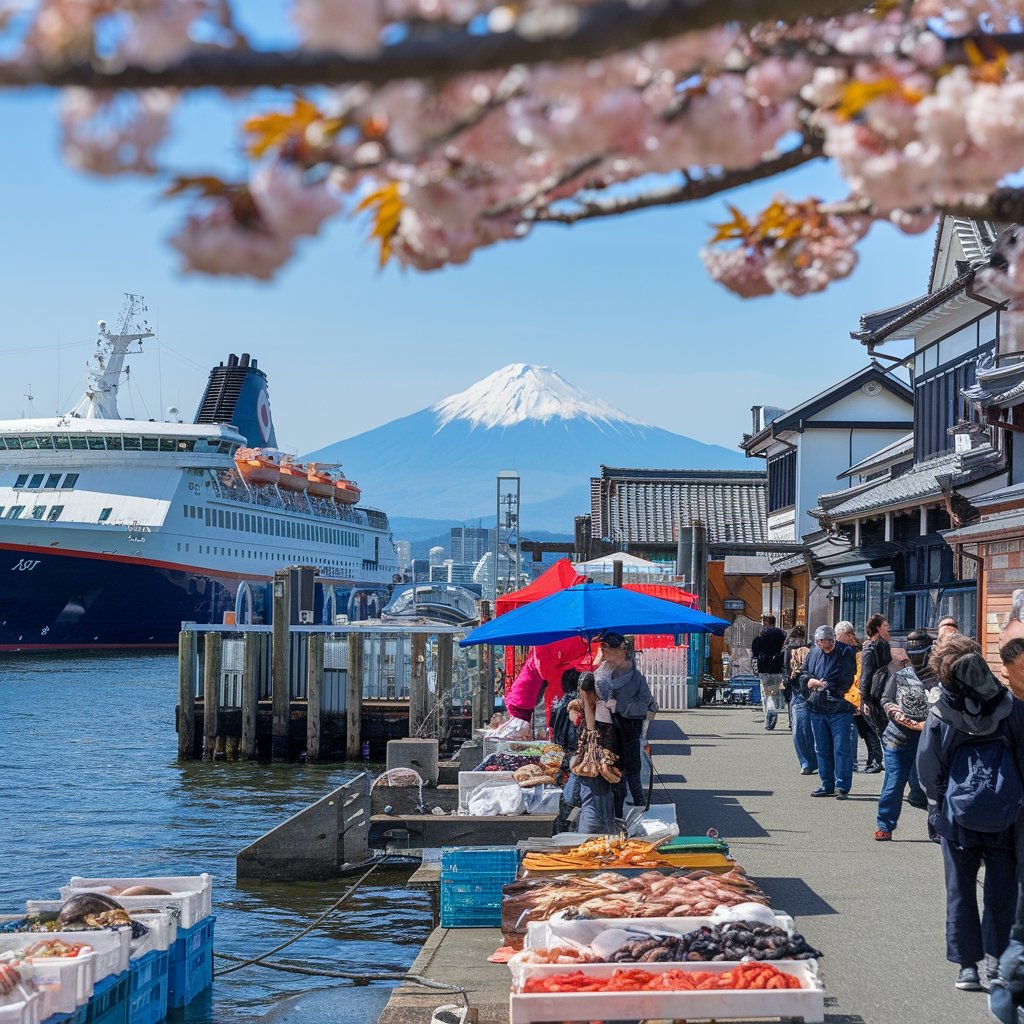
Sailing into Hakodate Port? You’re arriving at one of Japan’s most important harbors – the first international trade port that opened back in 1859. Most cruise ships pull up to Wakamatsu Wharf (with the new Hakodate Cruise Terminal) or Minato-cho Wharf if you’re on a bigger ship.
The port puts you in a great spot to check out the best local attractions. Don’t miss Mt. Hakodate‘s amazing night views, the cool star-shaped Goryokaku Fort, the bustling Morning Market, and the historic Motomachi District. Getting around is easy with free shuttle buses, local trams, or taxis. While you’re at the terminal, take a quick look at the Mashu Maru museum ship nearby.
Aomori Cruise Ship Port Guide
Welcome to Aomori’s snug harbor nestled in Mutsu Bay – your doorway to northern Honshu! You’ll pull in at either Shin-Chuo Wharf (the main spot with all the official entry stuff) or Okidate Pier. Both are just a stroll from downtown. The cruise terminal built in 2019 has free Wi-Fi and folks ready to point you in the right direction.
- Don’t miss the massive glowing warrior floats if you’re here during the Nebuta Festival in August
- Check out Hirosaki Castle surrounded by 2,500 cherry trees (crazy beautiful in late April-May)
- Hit up AUGA or Furukawa fish markets and pile your own seafood bowl exactly how you want it
Grab a fixed-rate taxi if you’re heading to Oirase Stream or other cool spots too far to walk.
Kanazawa Cruise Ship Port Guide
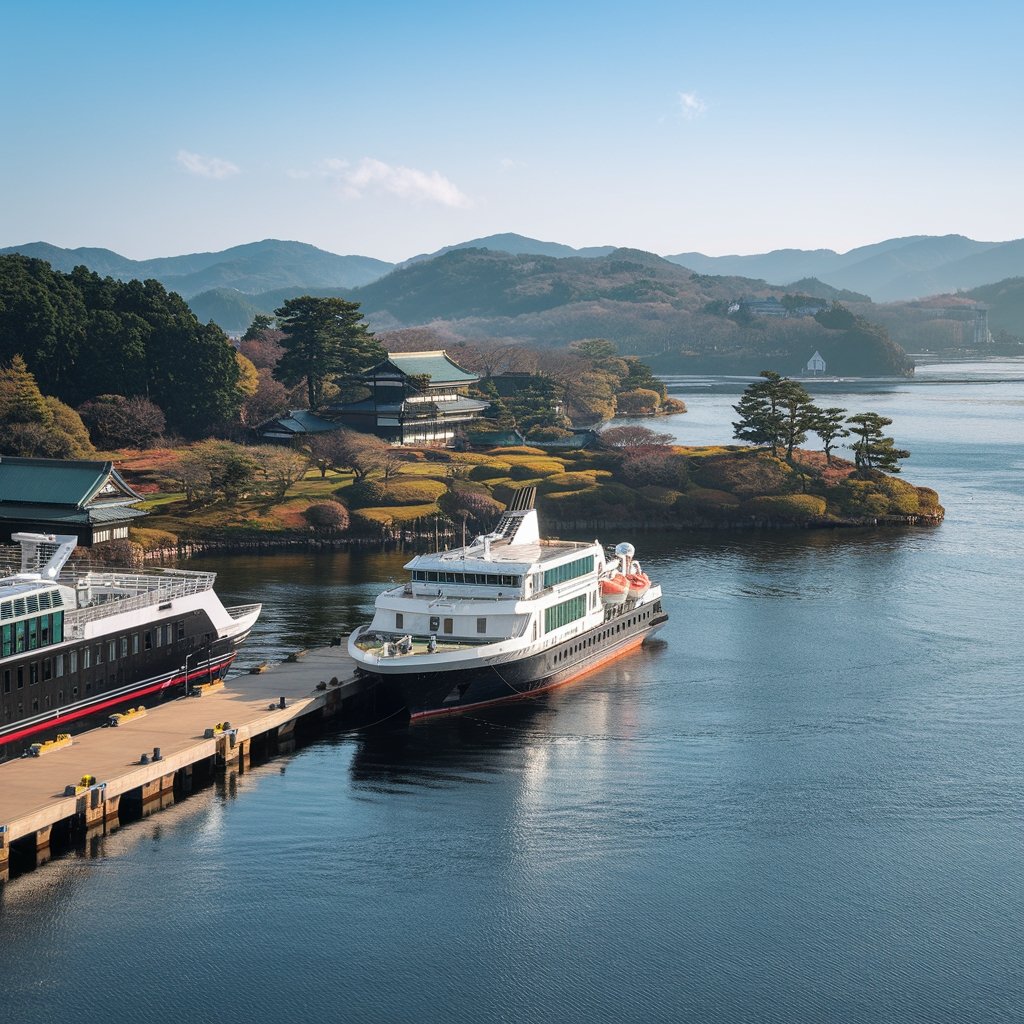
While Aomori welcomes you to northern Honshu, Kanazawa’s shiny new port throws open the doors to Japan’s western coast for cruise travelers. The terminal is a real looker with its wave-shaped roof, and it’s been up and running since June 2020.
Getting through customs is a breeze – they’ve set things up to handle 4,000 passengers in just a couple hours. Head up to the observation deck for some killer harbor views, or try your hand at Japan’s biggest ship simulator for a bit of fun.
The best part? You’re only 15 minutes from Kanazawa Station, which puts you in the perfect spot to check out Kenrokuen Garden, dive into the seafood treasures at Omicho Market, wander through the old geisha neighborhoods, or spend some time at the cool 21st Century Art Museum.
See what’s on offer from the Indonesia for a different Asia Cruise destination.
Okinawa (Naha) Cruise Ship Port Guide
Okinawa (Naha) Cruise Ship Port Guide
Your cruise will pull into Naha Port, tucked at Japan’s southern tip – a tropical getaway totally different from the mainland. You’ll dock at Wakasa Berth with its modern terminal offering free WiFi, places to swap currency, and helpful tourist info.
Just beyond the port, check out:
- Shuri Castle with its eye-catching red gates against the blue sky – a cool reminder of the Ryukyu Kingdom’s unique past
- Kokusai-dori street market where you can hunt for local crafts and sample some killer Okinawan food
- The super clear waters of Naminoue Beach, where an ancient shrine practically sits on those white sandy shores
Ishigaki Cruise Ship Port Guide
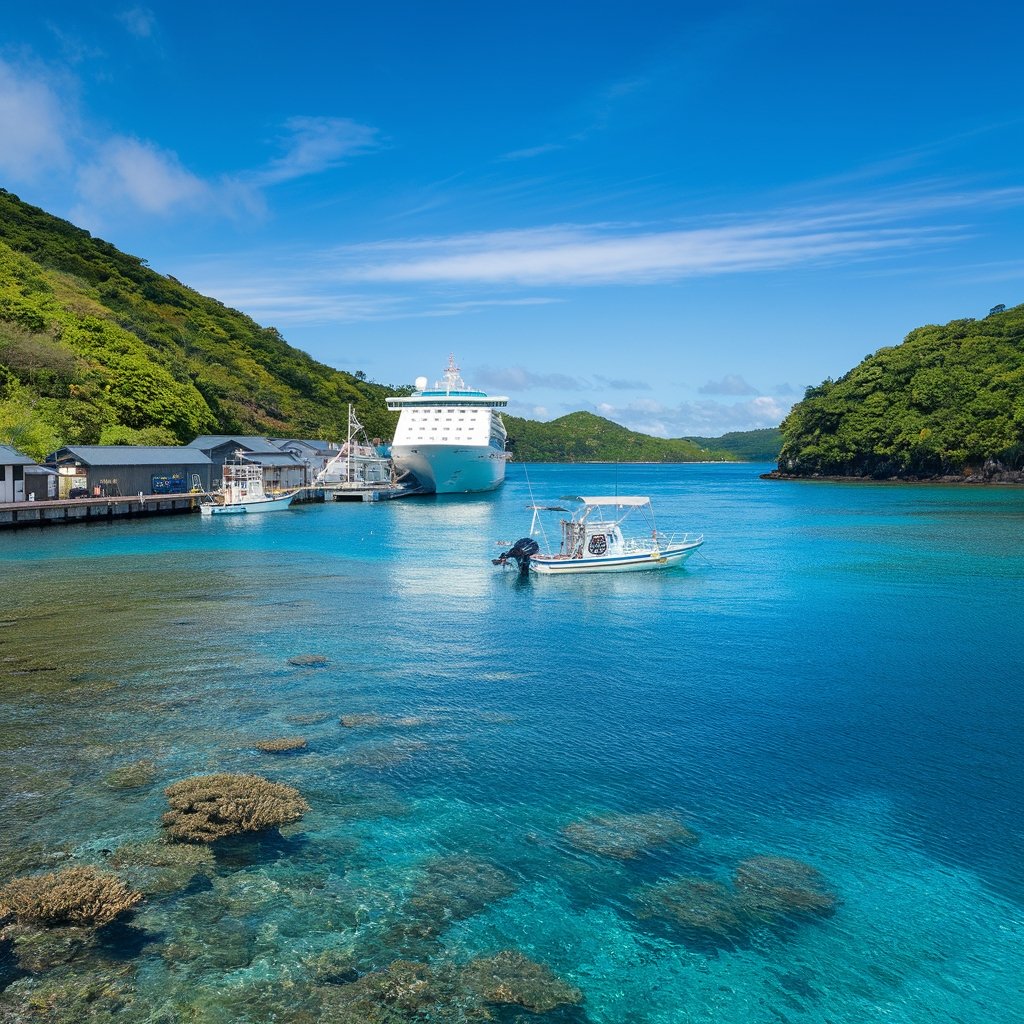
Welcome to Ishigaki – Japan’s laid-back westernmost city and your ticket to the gorgeous Yaeyama Islands!
Your cruise will pull into one of two spots: the RITOH Terminal (for smaller ships) or the New Port (for the big boats). Both have the essentials – Wi-Fi to post those vacation pics, places to grab food, and even a planetarium to check out.
The port puts you in a perfect spot to start adventuring. Hop on a quick ferry to Taketomi (just 15 minutes away) or head to wild Iriomote (40-minute ride). While you’re here, don’t skip the glass-bottom boat rides at Kabira Bay, snorkeling around the Sekiseishoko coral reef, or filling up on the local specialties – Ishigaki beef and Yaeyama soba noodles are total must-tries!
Beppu Cruise Ship Port Guide
Gateway to Kyushu’s steamy volcanic wonderland, Beppu Port has eight modern berths, with Wharf 3 handling big ships up to 140,000 GT. Grab the free shuttle to JR Beppu Station – it’s just 5km from the port.
Beppu must-sees:
- The Eight Hells with their mind-blowing cobalt blue and blood-red hot springs (seriously cool photo ops!)
- Jigoku-mushi cooking in Kannawa District – try the eggs and veggies cooked by actual volcanic steam
- Takasaki Monkey Park, where about 1,500 cheeky Japanese macaques hang out, just a quick bus ride away
Kochi Cruise Ship Port Guide
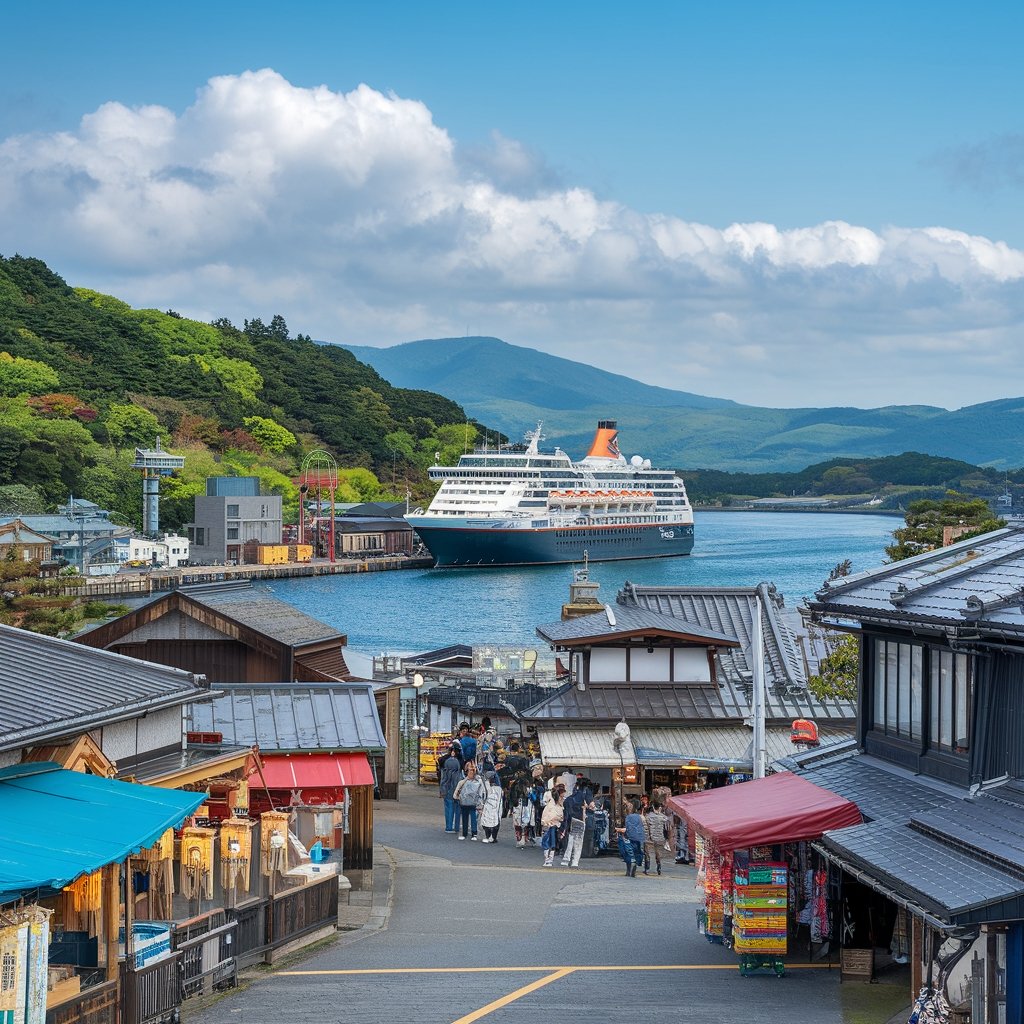
Kochi Port is the go-to cruise spot on Shikoku Island, with modern docks at Misato Wharves that can handle massive ships up to 250,000 GT. When you arrive, you’ll be greeted by locals performing traditional Yosakoi dances, and free shuttle buses will take you into town.
Check out Kochi Castle – it’s one of the few castles in Japan that wasn’t rebuilt or restored (the real deal!). Hungry? Head to Hirome Market and try katsuo no tataki – skipjack tuna seared over straw fires. Chikurin-ji temple has a gorgeous pagoda worth seeing, and the Niyodo River is incredibly blue and clear.
Getting around is easy – you’re only about 30 minutes by car from both the main train station and downtown Kochi.
Sapporo (Muroran) Cruise Ship Port Guide
Hokkaido’s industrial hub Muroran opens its doors to cruise ships at Shukuzu Wharf and Sakimori #6 berths, just 100 km from Sapporo. Look for tourist info and shuttle buses near the terminal, or stretch your legs with a 15-minute walk to JR Muroran Station.
While you’re exploring this northern island, check out:
- Cape Chikyu with its jaw-dropping coastal cliffs and fresh Pacific breezes
- Jigokudani (literally “Hell Valley”) where you can watch hot springs bubble and steam
- Lake Toya’s peaceful crater lake surrounded by volcanic mountains
Don’t leave without slurping down Muroran’s famous curry ramen! When you’re ready for the big city, hop on a train to Sapporo – it’s about a 2-hour ride.
Niigata Cruise Ship Port Guide
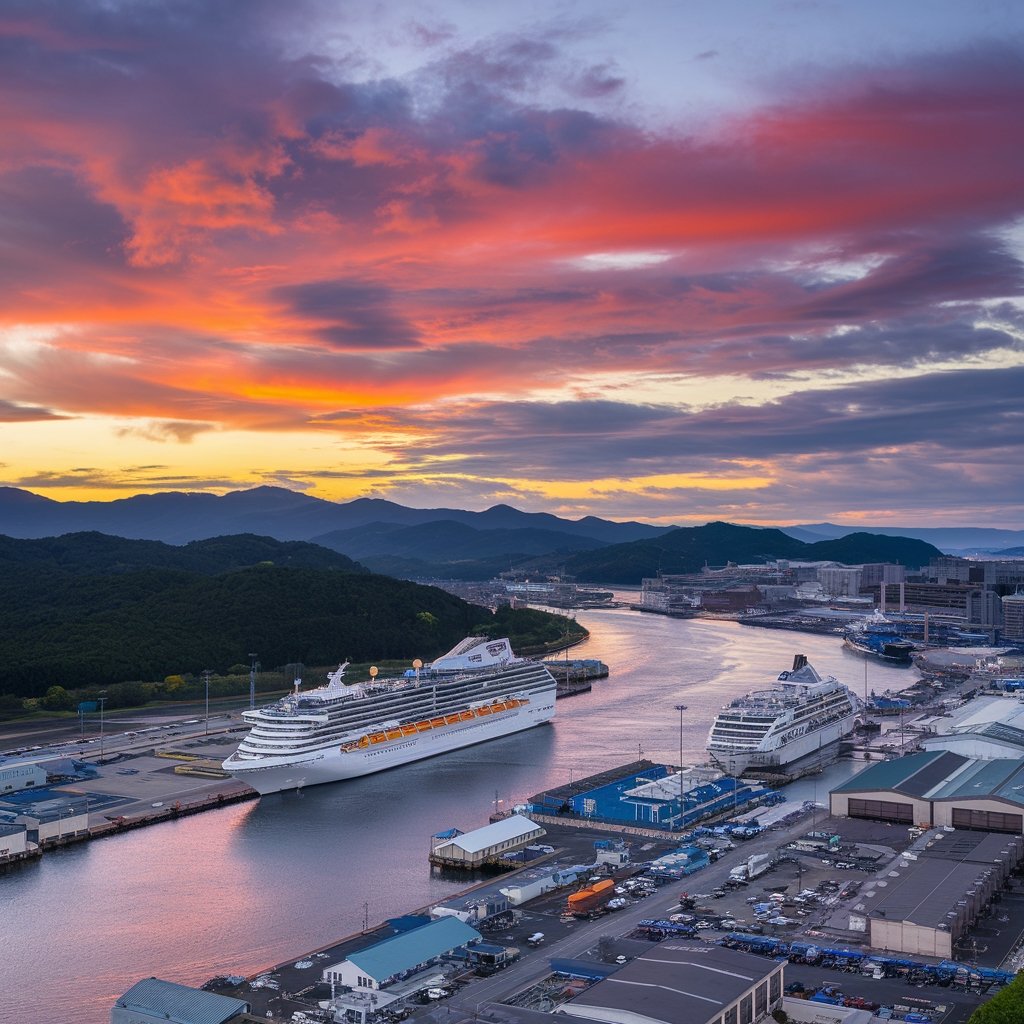
Cruising into Niigata? You’re landing at West Port’s Yamanoshita Wharf, a quick 4km jaunt from downtown. This central Honshu spot gives you a prime position on the Sea of Japan after leaving Hokkaido’s industrial vibes behind.
The passenger terminal hooks you up with free Wi-Fi while you plan your adventures. Get yourself to Sado Island to check out those rare ibises, wander the volcanic wonder of Kiyotsu Gorge, or poke around the Northern Culture Museum.
Thirsty? Niigata’s got you covered with over 90 sake breweries serving up drinks made from their famous Koshihikari rice. Catch a geisha show if that’s your thing, or shop for some sweet Murakami lacquerware souvenirs.
Want to hit Tokyo? Hop on the bullet train and you’ll be there in under 100 minutes. Easy.
Miyazaki (Aburatsu) Cruise Ship Port Guide
Miyazaki’s Aburatsu port isn’t fancy, but it gets the job done as your gateway to southern Japan. You’ll find basic facilities and temporary immigration services here, with shuttle buses ready to whisk you downtown in about 5 minutes.
The port itself is pretty bare-bones, but the real Japan starts once you get beyond the pier:
- Check out Obi Castletown where you can stroll through an old samurai neighborhood and explore the rebuilt fortress
- Don’t miss Udo Jingu Shrine with its striking red buildings tucked inside a seaside cave
- Grab a bite of local food – try the bonito grilled two different ways or sip some sweet potato shochu (the local booze)
Nagoya Cruise Ship Port Guide
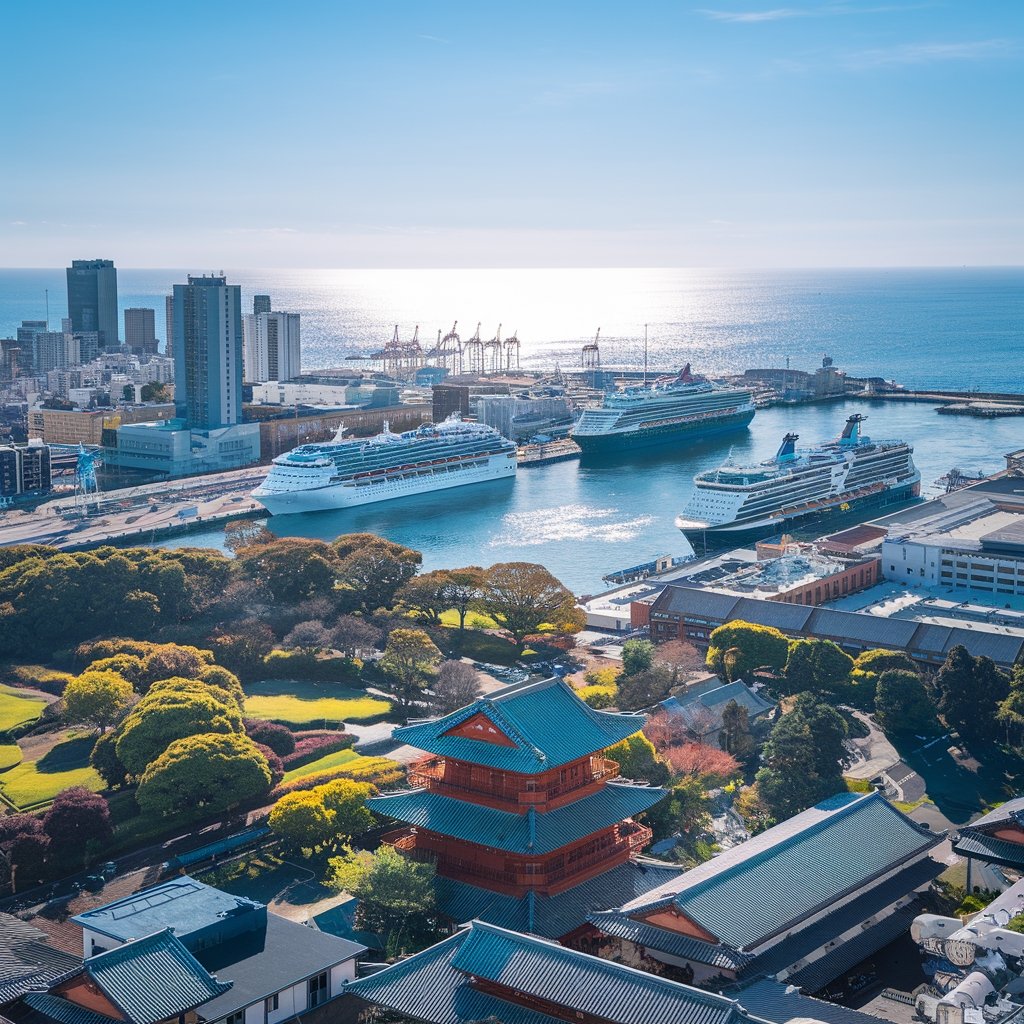
Miyazaki gives you that old-school southern Japan vibe, but Nagoya? Total opposite – it’s Japan’s industrial hub. Your ship will pull into either Garden Pier (check out the observation decks and museums) or Kinjo Pier if you’re on one of the bigger boats.
Once you’re off the ship, just hop on the subway at Nagoyako Station and you’ll hit downtown in about 7 minutes. Worth checking out: the Port Aquarium with some pretty awesome dolphin shows, the Antarctic Museum where you can explore the Fuji icebreaker, or LEGOLAND if that’s your thing. Hungry? Get your hands on some hitsumabushi (that’s grilled eel) or some crispy tebasaki chicken wings.
Pro tip: grab a “Mei-puru” day pass for ¥3,000 and cruise around Japan’s fourth-largest city without worrying about ticket prices.
Miyakojima Cruise Ship Port Guide
Miyakojima Cruise Ship Port Guide
Drop anchor at Miyakojima and discover Okinawa’s hidden gem in the East China Sea! Your ship will stop offshore at Hirara Port, where tender boats shuttle you to this slice of paradise.
Get ready to explore:
- Kick back on Maehama Beach’s stunning white sands – a swimmer and snorkeler’s dream
- Catch jaw-dropping views from the lighthouse at Higashi-Hennazaki Cape
- Hop across to Irabu Island via Japan’s longest free bridge (yep, no tolls!)
Best time to visit? April through November rocks for weather. Just pack cash – most places don’t take cards. And grab your transportation ahead of time since buses and taxis are pretty scarce.
Frequently Asked Questions
What Is the Best Season for Cruising Around Japan?
Looking to cruise Japan? Spring (March-May) is perfect for catching those gorgeous cherry blossoms, while fall (September-November) shows off amazing autumn colors. Both seasons have nice weather without too much rain, plus you’ll dodge summer’s nasty typhoons and skip the freezing northern winters. The scenery is absolutely worth planning around!
Are There Japanese Language Apps Helpful for Cruise Passengers?
You bet – a little Japanese goes a long way on your cruise! Grab apps like “Learn Japanese – Phrasebook” to use offline for the basics, or try LingoDeer to help with those everyday travel chats. Super handy when your ship docks at Japanese ports – trust me, locals appreciate the effort!
How Do Cruise Ships Handle Dietary Restrictions in Japanese Ports?
Cruise ships can totally work with your diet needs if you let them know ahead of time. On board, they’ve got staff who’ll whip up special meals for you. When you dock in Japan, they’ll hook you up with allergy cards in different languages and point you toward restaurants that won’t mess with your food restrictions.
What Cultural Etiquette Should Foreign Cruise Passengers Know Before Visiting?
When you’re strolling through those gorgeous cherry blossoms, don’t worry too much about the whole greeting thing. A small bow works well, but locals understand you’re a visitor. Do kick off your shoes when heading inside someone’s home or certain restaurants – it’s just good manners here. Try to keep your voice down in public spaces (especially on trains), and skip the tipping – it’s actually not expected in Japan. The Japanese really appreciate visitors who show a little respect for their customs, which are all about keeping things peaceful and considerate.
Are Japan Rail Passes Usable During Cruise Port Stops?
Yes, Japan Rail passes work during cruise port stops, but they only cover JR trains and buses. You’ll have to buy separate tickets for any city buses, subways, or private railways that connect cruise terminals to the nearest JR stations. Just something to keep in mind when planning your shore excursions!
Thinking about something different? Check out the cruises leaving from China Cruise Ports.
